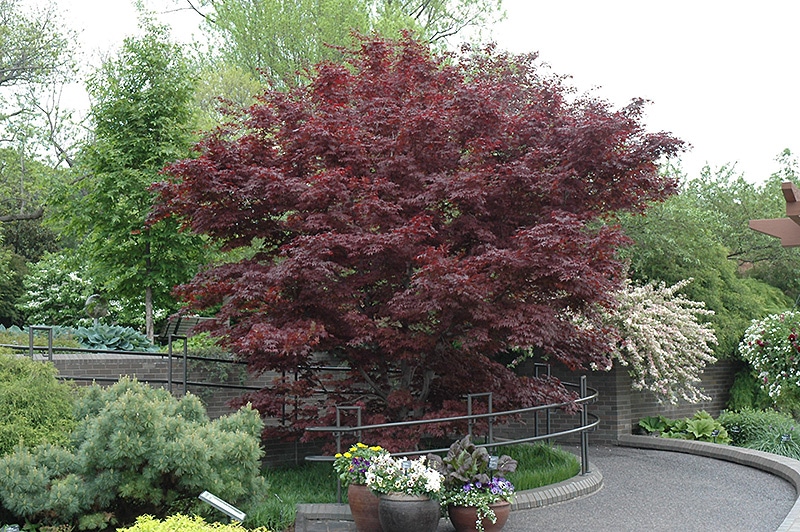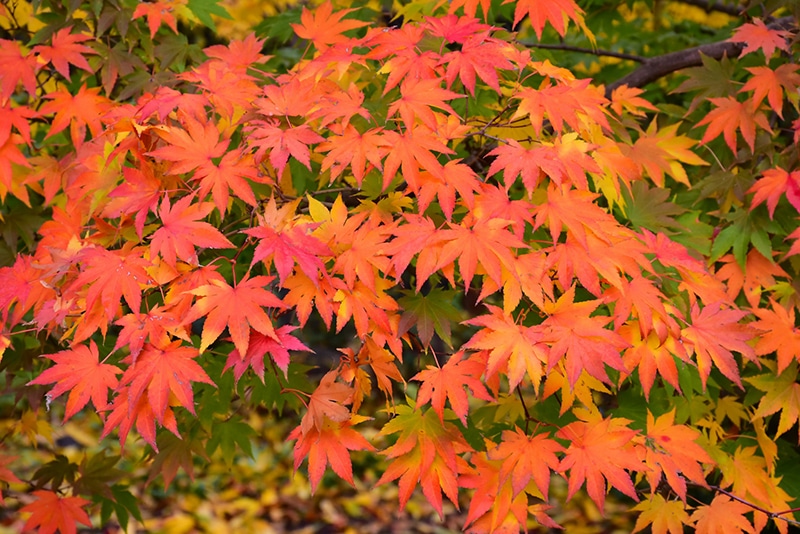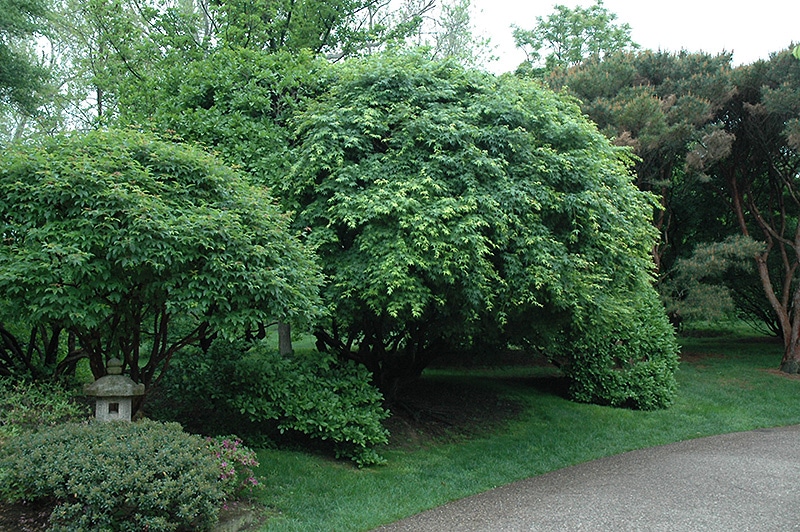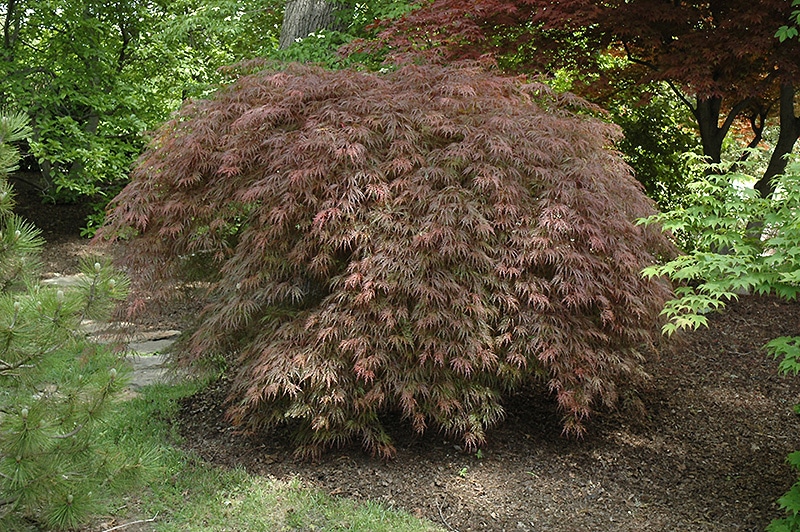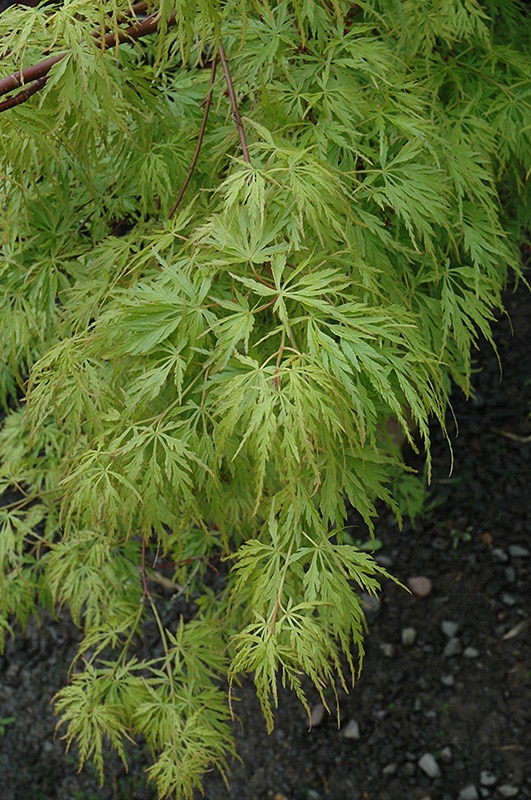Few plants can compare to the beauty and elegance of a Japanese Maple. It is widely renowned for its striking foliage. Its leaves have between five and nine palmate lobes that come in red or green. The leaves of some varieties have fine, lacey lobes, while other varieties have wider, more substantial lobes. In the fall the leaves turn to brilliant shades of red, yellow, orange or purple. These highly attractive leaves will remain on display for weeks before dropping to the garden floor, creating brilliant pools of color beneath the bare branches.
Japanese Maples are versatile additions to the landscape and can be planted alone as individual specimen, as an accent in the garden to draw the eye to its blazing canopy of color, or in a large planting along a walk, driveway, or slope to create a ribbon of color brighter and more attractive than the most beautiful accent lights. Many varieties are also dwarf enough to be grown in containers or even as bonsai.
Things to Consider
When to Plant
As the saying goes, “The best time to plant a tree is yesterday.” If that did not happen, then the ideal planting time is now! If you plant in the fall, you take advantage of the new root growth that occurs during the dormant season. Unlike the tops of the maple that go dormant and cease growth for the winter, roots of maples continue to grow throughout the fall and early winter months if temperatures are not below freezing. Fall planting also allows the carbohydrates that are produced during the summer to be directed to root growth since there is little demand from the top. If you are planting in spring, avoid disturbing any plant parts that recently have broken bud and are producing new, soft growth.
Where to Plant
The placement of your Japanese Maple can mean the difference between an attractive, lush-growing tree and a scraggly, struggling tree. With so many cultivars to choose from this should not be a problem as you should be able to match your landscape situation with the right cultivar. Try to match your maple cultivar to your planting location with regards to the amount of sun, wind exposure and space availability the tree will receive. Young trees will need some protection from harsh elements until they have formed more established roots.
As you decide on the best location to place your new tree, keep in mind that morning sun and afternoon shade will best serve most maples. Extreme wind and baking sun can damage a small tree in no time, regardless of the cultivar. The leaves of damaged trees will show signs of stress, including burning on the tips. Young Japanese Maples have thin bark and can be sun scalded during the first year or two after transplanting. This injury can set back the tree’s growth considerably.
Soil Preparation
Clay and poor draining soils
Poorly drained soils are a leading cause of plant problems in the landscape. It is a good idea to incorporate about 10% to 20% organic matter into the soil to help with drainage and aeration. Use only well-composted mulches. A quality bag of potting soil mixed in will work just as well. Avoid fine-textured organic matter, such as sand or peat moss. Composted materials immediately provide organic matter to the soil and help with aeration. Do not use green bark products as amendments. Freshly milled bark that has not been composted will slowly rob plants of nitrogen when used as an amendment. As microorganisms in the soil feed on bark and decompose it, they will use nitrogen in the soil. Also, the pH of the soil often drops dramatically below the desirable range when non-composted materials are used as amendments.
Japanese Maples generally do not thrive in clay, heavy or poorly drained soils. These types of soils can lead to root rot and bring about disease. Additionally, plants breathe through their roots and these soil types are not suitable for growth because they are low in oxygen required for good root growth.
Poor drainage should be improved, if possible, by grading or installing drain tiles (perforated pipes) to carry excess water away from the roots. On flat sites or where drainage or compaction problems are less severe, trees can be planted shallow, with one-third or more of the root ball above grade and backfill soil mounded to cover the root system. Trees can even be placed on top of the existing, problem soil with their roots surrounded by a mound or berm. Such trees may do well but also may have a smaller root system and will need more care and attention than trees on better sites.
Be sure to build the soil up beside the root ball so that the sides are not exposed, and do not place additional soil on top of the root ball. This will allow oxygen to reach the roots in the upper surface of soil. Do not disturb the soil under the root ball to prevent any later settling, which will move the plant roots deeper into the soil.
Sandy or Well Drained Soils
In well-drained soil, the planting hole should never be dug any deeper than the height of the root ball. The planting hole should be at least twice and preferably five times wider than the root ball. Roots will grow more quickly into loosened soil, thus speeding up the tree’s establishment time. Mulch should be placed over the surface.
Mulching
Mulch is a good friend of your Japanese Maple. Mulch protects the roots from the heat during the summer, from the cold during the winter and reduces the frequency of watering. Apply a loose mulch, such as wood chips, shredded bark or pine needles over the planted area to a depth of 3 to 6 inches. Be sure to keep mulch several inches away from the trunk of the tree. Be sure to mulch any trees you plant in containers.
Watering
Japanese Maples are quite drought-tolerant when mature. However, like most young trees, they need regular, deep watering during the first few years. Plan to water heavily twice a week during normal weather and three or even four times weekly in periods of drought. Whether your tree is young or mature, it will grow best in soil kept consistently moist by regular watering and mulching.
To encourage the most spectacular color show in fall, reduce the amount of water you give your Japanese Maple in late summer and early autumn. Of course, do not let it dry out completely, but cut back so that it stops producing more green leaves and begins its fabulous color changes. You will be amazed at the difference this makes!
Seasonal Considerations
Spring
Spring is the most vulnerable time for your Japanese Maple. The tree may leaf out early and then suffer in late frosts. Consider keeping young Japanese Maples covered whenever frost threatens. As soon as the weather settles down, begin a regular watering and feeding schedule.
Japanese Maples are often planted during the springtime while temperatures are moderate. If you plant in spring, avoid disturbing or damaging any plant parts that recently have broken bud and are producing new, soft growth.
Summer
During summer you may notice pests on your Japanese Maple. Most of them are completely harmless. If aphids become a problem, treat them with the same pesticide used for roses, and they will vanish.
During very hot weather you may notice the ends of the leaves drying out and curling. This is unsightly and may indicate that your tree needs more shade, but unless it occurs over a long period every year, it will not be fatal. Stressed Japanese Maple have been known to drop all their leaves and still recover beautifully. Often re-leafing during the same season.
As summer draws to a close, reduce the amount of water you give your Japanese Maple. This will stimulate those magnificent color changes more quickly and intensely.
Fall
This is one of the best times to plant a Japanese Maple. Ideally, your fall plantings should occur at least a month before the ground freezes so your tree has time for some root growth before winter. But if you find yourself planting late, don’t worry. Your tree will wait patiently until spring to begin settling into its new home.
Unless your weather turns exceptionally dry, reduce the amount of water you give the tree in fall. This will stimulate better color changes. As fall comes to a close, be sure your Japanese Maple has a nice thick layer of mulch to help protect its roots against the extreme cold of winter. Remember not to place mulch against the trunk of the tree.
Winter
If planted within their hardiness range, and with its roots appropriately mulched, winter is generally a carefree season for your Japanese Maple. The only concern is heavy snow loads, which might cause some branches to snap. After a particularly heavy snowfall, brush away any large accumulation of snow, being careful not to treat the branches too roughly. Ice, on the other hand, should be left in place. It freezes onto the branches and is best left alone.
Pruning
There are several reasons to prune. The primary reasons are related to the health of the tree, while aesthetics also play a big part. Reasons for pruning may include:
- Direct growth and structure. By pruning, you can direct growth habits and influence the structure of the tree as it grows.
- Improve airflow. Increased airflow through branches decreases the likelihood of disease.
- Removal of dead, diseased, or damaged branches. These should always be removed first for the health of the tree.
- Prevent unwanted growth. If a branch is growing into a power line, house eave, or other unwanted areas, it should be removed.
- Reduce weight. If a branch is too heavy, trimming can reduce its weight.
For Japanese maples, it is recommended to do structural pruning in the winter and wait until late spring, after the leaves come out, for fine pruning. Summer can also be a good time for removing larger branches and for removing dead, damaged, or diseased wood.
Properly pruning Japanese Maples can be tricky. If you are not experienced, you should consider hiring a professional to prune your tree. If you plan to prune your Japanese Maples yourself, be sure to study up on proper methods before making that first cut. There are many resources online that can guide your efforts. With so many opinions and methods out there, be sure to use only reputable sources!

